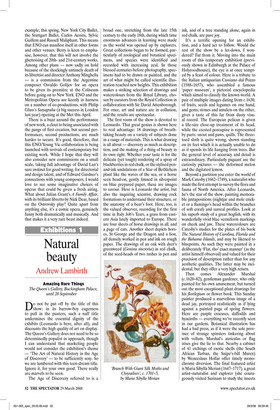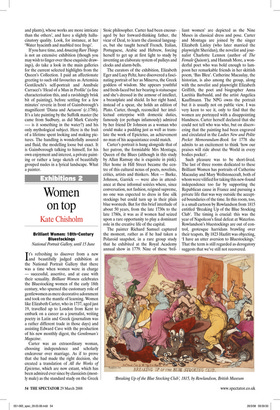Natural beauty
Andrew Lambirth
Amazing Rare Things
The Queen’s Gallery, Buckingham Palace, until 28 September Do not be put off by the title of this show: in its barrow-boy eagerness to pull in the punters, such a naff title undermines the essential dignity of the exhibits (Leonardo is here, after all), and discounts the high quality of art on display. The Queen’s Gallery does not need to be so determinedly populist in approach, though I can understand that marketing people would not consider the exhibition’s theme — ‘The Art of Natural History in the Age of Discovery’ — to be sufficiently sexy. So we are lumbered with this teen-dream title. Ignore it, for your own good. There really are marvels to be seen.
The Age of Discovery referred to is a broad one, stretching from the late 15th century to the early 18th, during which time enormous advances in learning were made as the world was opened up by explorers. Great collections began to be formed, particularly of zoological and botanical specimens, and species were identified and recorded with increasing zeal. In those blessed centuries before photography, specimens had to be drawn or painted, and the art of what might be called scientific illustration reached new heights. This exhibition makes a striking selection of drawings and watercolours from the Royal Library, chosen by curators from the Royal Collection in collaboration with Sir David Attenborough. For once, art and nature are in collusion, and the results are spectacular.
The first room of the show is devoted to Leonardo. That great genius is shown here to real advantage: 18 drawings of breathtaking beauty on a variety of subjects done in a range of materials. This is what drawing is all about — discovery as much as description, and the making of a thing of beauty in its own right. Whether your taste is for the delicate (yet tough) rendering of a spray of blackberries in red chalk, or the stylised penand-ink undulations of a Star of Bethlehem plant like the waves of the sea, or a horse seen head-on, gently limned in silverpoint on blue prepared paper, these are images to savour. Here is Leonardo the artist, but also the inquiring scientist, drawing rock formations to understand their structure, or the anatomy of a bear’s foot. Here, too, is the valued observer, recording for the first time in Italy Job’s Tears, a grass from eastern Asia lately imported to Europe. There are four sheets of horse drawings in all, and a page of cats. Another sheet depicts horses, St George and the Dragon and a lion, all densely worked in pen and ink on rough paper. The drawings of an oak with dyer’s greenweed (Genista tinctoria) in red chalk, of the seed-heads of two rushes in pen and ink, and of a tree standing alone, again in red chalk, are pure joy.
It’s a terrific opening for an exhibition, and a hard act to follow. Would the rest of the show be a let-down, I wondered? Far from it. Moving into the main room of this temporary exhibition (previously shown in Edinburgh at the Palace of Holyroodhouse), the eye is at once tempted by a feast of colour. Here is a tribute to the Italian antiquarian Cassiano dal Pozzo (1588–1657), who assembled a famous ‘paper museum’, a pictorial encyclopedia which aimed to classify the known world. A pair of multiple images dating from c.1630, of fruits, seeds and legumes on one hand, and gems, stones and amulets on the other, gives a taste of this far from dusty visual record. The European pelican is given a life-size close-up treatment of its head, while the crested porcupine is represented by parts: snout and paws, quills. The threetoed sloth is quite wrong, shown standing on its feet which it is actually unable to do as it spends its life hanging from trees. But the general level of accuracy and detail is extraordinary. Particularly piquant are the curiosity pictures — the deformed melon and the digitated lemon.
Beyond a partition you enter the world of Mark Catesby (1682–1749), a naturalist who made the first attempt to survey the flora and fauna of North America. After Leonardo, he’s the star of the show, painting memorable juxtapositions (nightjar and mole cricket or a flamingo’s head within the branches of soft coral) and surreal profiles. Look at his superb study of a great hogfish, with its wonderfully vivid blue vermiform markings on cheek and jaw. These watercolours are Catesby’s studies for the plates of his book The Natural History of Carolina, Florida and the Bahama Islands, and may be likened to blueprints. As such they were painted in a deliberately ‘Flat, tho’ exact manner’ (as the artist himself observed) and valued for their precision of description rather than for any aesthetic qualities. The latter may be incidental, but they offer a very high return.
Then comes Alexander Marshal (c.1620–82), gentleman gardener, who only painted for his own amusement, but turned out the most exceptional plant drawings for his florilegium or flower book. This Sunday painter produced a marvellous image of a dead jay, portrayed realistically as if lying against a painted page of spring flowers. Here are purple crocuses, daffodils and hyacinths — everything we’ve recently seen in our gardens. Botanical illustration has had a bad press, as if it were the sole province of strange spinsters tinkering about with vellum. Marshal’s auriculas or flag irises give the lie to that. Nearby a cabinet of 41 etchings of exotic shells (the South African Turban, the Snipe’s-bill Murex) by Wenceslaus Hollar offer timely monochrome diversion. The final featured artist is Maria Sibylla Merian (1647–1717), a great artist–naturalist and explorer (she courageously visited Surinam to study the insects and plants), whose works are more intricate than the others’, and have a slightly hallucinatory quality. Look, for instance, at her ‘Water hyacinth and marbled tree frogs’.
If you have time, and Amazing Rare Things is not an extensive exhibition (though you may wish to linger over these exquisite drawings), do take a look in the main galleries for the current selected highlights from the Queen’s Collection. I paid an affectionate greeting to such old favourites as Artemisia Gentileschi’s self-portrait and Annibale Carracci’s ‘Head of a Man in Profile’ (a fine characterisation this, and a ravishingly brisk bit of painting), before settling for a few minutes’ reverie in front of Gainsborough’s magnificent ‘Diana and Actaeon’ (c.1786). It’s a late painting by the Suffolk master (he came from Sudbury, as did Mark Catesby —is it something in the water?) and his only mythological subject. Here is the fruit of a lifetime spent looking and making pictures. The handling is wonderfully assured and fluid, the modelling loose but exact. It is Gainsborough talking to himself, for his own enjoyment and interest, a private painting or rather a large sketch of beautifully grouped nudes in a lyrical landscape. What a painter.

















































































 Previous page
Previous page